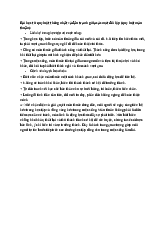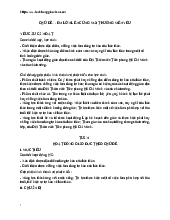












Preview text:
lOMoARcPSD| 10435767
Economics 203: Intermediate Microeconomics I Sample Final Exam 1
Instructor: Dr. Donna Feir Instructions:
• Make sure you write your name and student number at the top of this page.
• You have 3 hours to complete this exam. In order to minimize distractions to others,
you are not permitted to leave in the last 10 minutes of the exam.
• You should answer all questions.
• Write your answers in the space provided. Use the backside of your exam for scrap
paper if you wish, but only information written in the space provided will be considered
for grading. You may also tear off the last page of the exam and use it for scrap paper.
• Use your time wisely. If you get stuck on a question move onto the next question and return if time permits.
• There are three sections to the exam:
Section A is worth 100 points in total and consists of 20 multiple choice questions. It
is possible to get part markets if you clearly demonstrate some correct knowledge of the material.
Section B Is worth 20 points in total and consists of 4 short answer questions
Section C is worth 80 points in total and consists of 4 long problems of varying length.
Section A: Multiple Choice - 100 points total
1. Along a given indifference curve lOMoARcPSD| 10435767
a. Both the combination of goods and the consumer’s income remain constant
b. The combination of goods remains constant
c. The combination of goods remains constant but the level of utility varies
d. The combination of goods varies but the level of utility remains constant
2. Ordinal utility theory assumes that consumers can
a. Rank baskets of goods as to their preference
b. Determine the number of utils that can derived from consuming all goods
c. Determine the MRS between goods
d. Avoid the law of diminishing marginal utility e. All of the above
3. In spending all his or her income, the consumer chooses the market basket that maximizes
his or her utility. Which of the following statements will be correct? i.
The marginal utility is the same for each commodity. ii.
The marginal utility per dollar spent is the same for each commodity. iii.
The marginal utility of each commodity is proportional to its price. a. i only b. ii only c. i and ii only d. ii and iii only e. i, ii, and iii
4. If Fred’s MRS of salad for pizza equals to -5 (where salad is on the vertical axis), then which of the following is true?
a. He would give up 5 pizzas to get the next salad
b. He would give up 5 salads to get the next pizza
c. He will eat 5 times as much pizza as salad
d. He will eat 5 times as much salad as pizza
e. He must trade 5 times as much
5. A normal good can be defined as one which consumers purchase more of as a. prices fall b. prices rise lOMoARcPSD| 10435767 c. incomes fall d. incomes increase
e. the prices of other products increase
6. When demand for a good is inelastic, consumer expenditures on the good
a. increase when price increases
b. decrease when price increases
c. do not change when price increases
d. are not related to price elasticity of demand
e. are relatively more elastic
1. If Q = 2L + 4K, which of the following is false?
A. The MRTS is a constant equal to ‰ if L is on the horizontal axis
B. The MPK = 4 units of output for each additional unit of K input
C. The production function displays constant returns to scale
D. K and L are perfect complements in production
E. K and L are perfect substitutes in production
7. If average total cost is decreasing in the short run a. Total costs are decreasing
b. Average variable cost is decreasing
c. Marginal cost is decreasing
d. Marginal cost is less than average total cost e. B and D
8. You observe the following production relationship: F(aK, aL) > aF(K, L) . From this, you can conclude that
a. the total cost of production is falling
b. the marginal product of L and K are increasing
c. there are increasing returns to scale
d. you should expand production e. c and d
9. If average fixed cost is 40 and average variable cost is 80 for a given output, we then know that average total cost is a. 40 lOMoARcPSD| 10435767 b. 120 c. 80 d. increasing
e. not possible to determine with the information given
10. If in the short run, a perfectly competitive firm is producing at an output where price is greater
than the minimum of long run average cost
a. The firm will necessarily make a profit in the long run
b. The firm will necessarily make a profit in the short run
c. The firm will have to reduce its price in the long run
d. The firm will not cover its fixed costs
e. The firm will have exit in the long run
11. In a short-run production process, the marginal cost is rising and the average variable cost
is falling as output is increasing. Thus,
a. average fixed cost is constant
b. marginal cost is above average variable cost
c. marginal cost is below average fixed cost
d. marginal cost is below average variable cost
e. average total cost is rising
12. For a firm operating in a perfect market, its short-run supply is identical with the rising arm of
a. its marginal-cost curve where price> average-total-cost
b. its average-fixed-cost curve where price> average-total-cost
c. its average-total-cost curve where price> average-variable-cost
d. Its average-total cost curve where price> average-total-cost
e. Its marginal-cost curve where price> average-variable-cost
13. In a consumer product Edgeworth box, a position on the contract curve
a. is always preferred by consumers to some position off the contract curve.
b. is always more fair than some other position somewhere off the contract curve.
c. is always Pareto optimal
d. is always defined where 𝑀𝑅𝑆𝐴 = 𝑀𝑅𝑆𝐵
e. is described by none of the above lOMoARcPSD| 10435767
14. In order to derive systematically the size of any single consumer good’s Edgeworth box, we need to know
a. the endowments of each consumer of each good
b. the preferences of each consumer and their contract curve
c. either a or b because they both amount to the same information
d. both a and b plus the set of individual rational trades
e. the core of the economy
15. A movement from A to C represents
a. A potential pareto improvement
b. A pareto improvement
c. A movement from an inefficient allocation to an efficient allocation
d. A movement from an efficient allocation to an inefficient allocation
e. A movement away from an equilibrium allocation Clothing A B C Food
16. In a Bertrand duopoly, each player tries to
a. maximize its own profit
b. maximize its own market share c. maximize its price
d. minimize the profits of its opponents
e. minimize the market shares of its opponents
17. In a cartel, the incentive to cheat is significant because lOMoARcPSD| 10435767
a. each firm has an incentive to decrease its own output
b. each firm has an incentive to raise its price
c. each firm has an incentive to expand its output
d. each firm’s marginal cost exceeds the price that the cartel sets
e. each firm has an incentive to deviate from the Nash equilibrium
18. When firms in monopolistic competition are earning an economic profit, firms will
a. enter the industry, and demand will decrease for the original firms
b. enter the industry, and demand will increase for the original firms
c. exit the industry, and demand will increase for the firms that remain
d. exit the industry, and demand will decrease for the firms that remain
e. expand production their production if they are a “first mover” firm
19. In order to be self-enforcing, an oligopoly strategy must:
a. be a Nash equilibrium b. increase output c. decrease output
d. maximize joint profit
e. earn each firm larger equilibrium profits
20. A monopolist faces a downward-sloping demand curve because
a. its average revenue equals its marginal revenue
b. its supply curve is upward sloping
c. it sells typically to only one consumer
d. its demand curve is the market demand curve
e. demand is perfectly inelastic.
Section B: Short Answer – 20 points total
1. Explain the relationship between costs in the short run and costs in the long run. In your answer
define what the “short run” means.
In the short run at least one factor of production is fixed, thus firms face fixed costs in the short
run. In the long run, all factors are variable. Long run costs will always be below short run costs –
in fact, the long run average cost curve is the lower envelope of all short run average cost curves. lOMoARcPSD| 10435767
2. List two factors that affect how price-elastic demand for a particular good is at a moment in time and explain
Two factors that affect how price-elastic demand is include the availability of substitutes and
whether the good is a normal or inferior. The availability of substitutes imply that consumers can
shift their consumption away from a give good if the price increases without a large cost to utility.
Whether a good is normal or inferior tells us whether the income effect works in the same
direction as the substitution effect of a price change. If the income effect works in the opposite
direction (as with an inferior good) the net change in quantity consumed from a price change will
be less than if the income effect worked in the same direction.
Other factors that affect the price elasticity of demand include how big a component of a
consumer’s total expenditures goes toward a particular good (this will influence the size of the
substitution effect). Another factor is time. With more time, a consumer is able to rearrange their
consumption bundle to allow for a greater reduction in consumption of an expensive good (for
example in the short run, a consumer may not be able to substitute away from gas very easy, but
in the long run they may switch from an SUV to a hybrid to avoid the costs of gas).
3. Define what is a long-run equilibrium in a perfectly competitive, endowment economy.
A long-run equilibrium is where:
1. Consumers are maximizing their utility
2. Consumers are on their budget constraints (spending all their income)
3. Supply for a good equals demand for all goods
4. Rank the following market structures in terms of the highest equilibrium price to the lowest:
perfect competition, Stackleberg competition, monopoly, Cournot competition, Bertrand competition, shared monopoly
Monopoly, shared monopoly, cournot, stackleberg, bertrand
Section C: Long Answer – 80 points total
1. Xiaoyu spends all her income on statistical software (S) and clothes (C). Her preferences can be
represented by the utility function: 𝑈(𝑆, 𝐶) = 4 ln(𝑆) + 6 ln(𝐶)
a. Compute the marginal rate of substitution software for clothes (software is on the
vertical axis). Is the MRS increasing or decreasing in S? How do we interpret this?
𝑴𝑹𝑺 = 𝑴𝑼𝑪 = 𝟔 × 𝑺 = 𝟑𝑺 𝑴𝑼𝑺 𝒄 𝟒 𝟐𝑪 lOMoARcPSD| 10435767
The MRS is increasing in S. This means as Xiaoyu gets more software, she is willing to
give up more software to get an additional unit of clothes.
b. Find Xiaoyu’s demand functions for software and clothes, 𝑄𝑆(𝑃𝑆, 𝑃𝐶,𝑀) and
𝑄𝐶(𝑃𝑆, 𝑃𝐶,𝑀), in terms of the price of software (𝑃𝑆), the price of clothes (𝑃𝐶), and Xiaoyu’s income (𝑀) 𝟑𝑺 𝑷𝑪 𝟐𝑷𝑪𝑪 = → 𝑺 = 𝟐𝑪 𝑷𝑺 𝟑𝑷𝑺
𝑴 = 𝑷𝑺𝑺 + 𝑷𝑪𝑪
𝑴 = 𝑷𝑺 (𝟐𝑷𝟑𝑷𝑪𝑺𝑪) + 𝑷𝑪𝑪 𝑴 =
𝟐𝑷𝟑𝑪 𝑪 + 𝑷𝑪𝑪 → 𝑴 = 𝟓𝟑 𝑷𝑪𝑪 → 𝑪∗ = 𝟓𝑷𝟑𝑴𝑪 , 𝑺∗ = 𝟓𝑷𝟐𝑴𝒔
c. Find Xiaoyu’s optimal bundle of software and clothes if her income is $100 and the price
of software is 2 and the price of clothes is 3. 𝑪 𝟐𝟎, 𝑺 𝟐𝟎 𝟓(𝟑) 𝟓(𝟐)
2. The government of a country called “Regula” currently guarantees its 10,000 wheat farmers a
price of P=30 per bushel of wheat, and does not allow new farmers to start growing wheat.
Furthermore, the government forbids imports or exports of wheat (Regula is a closed economy
in this entire question). The short-run cost function of each farm in Regula is 𝐶(𝑞𝑖) = 0.5𝑞𝑖2 +
4𝑞𝑖 + 200 where qi is the farm’s output in bushels of wheat. Aggregate demand for wheat is
given by Q =-10,000P+400,000.
a. Derive the supply curve of wheat in Regula.
The supply curve in a competitive market is equal to marginal cost as long as price is greater than
average variable cost. Marginal cost curve:
𝝏𝑪𝝏𝒒(𝒒𝒊𝒊) = 𝒒𝒊 + 𝟒, in a competitive market, price equals marginal cost for the
optimizing firm so, so the supply curve for an individual firm is 𝑷 = 𝒒𝒊 + 𝟒 as long as price>AVC. Thus lOMoARcPSD| 10435767
the supply curve for the whole industry is 𝚺𝒒𝒊 = −𝟒𝟎,𝟎𝟎𝟎 + 𝟏𝟎, 𝟎𝟎𝟎𝑷 → 𝑸 = −𝟒𝟎, 𝟎𝟎𝟎 + 𝟏𝟎, 𝟎𝟎𝟎𝑷 → 𝑷 =
𝟏𝟎,𝟎𝟎𝟎𝟏 𝑸 + 𝟒.
A UVic economics student has worked for a coop term at the Regula government and advised allowing
farmers to produce wheat under competitive circumstances.
b. Compute the price per bushel of wheat immediately after the implementation of the student’s proposal.
Supply will equal demand:
𝑸𝑫 = 𝟒𝟎𝟎, 𝟎𝟎𝟎 − 𝟏𝟎,𝟎𝟎𝟎𝑷 𝑸𝑺
= 𝟏𝟎, 𝟎𝟎𝟎𝑷 − 𝟒𝟎, 𝟎𝟎𝟎
𝑸𝑺 = 𝑸𝑫 → 𝟒𝟎𝟎, 𝟎𝟎𝟎 − 𝟏𝟎, 𝟎𝟎𝟎𝑷 = 𝟏𝟎, 𝟎𝟎𝟎𝑷 − 𝟒𝟎, 𝟎𝟎𝟎 → 𝟒𝟒𝟎, 𝟎𝟎𝟎 = 𝟐𝟎, 𝟎𝟎𝟎𝑷 → 𝟐𝟐 = 𝑷∗
Thus 𝑸∗ = 𝟏𝟎,𝟎𝟎𝟎(𝟐𝟐) − 𝟒𝟎, 𝟎𝟎𝟎 = 𝟏𝟖𝟎, 𝟎𝟎𝟎
A UBC coop student also worked for a coop term at the Regula government. This student values growing
produce locally and advised the government to split the market into 10,000 local communities, and to
allow each of the 10,000 farmers to serve just one such local community.
c. If demand in each local community is Q=40-P, what would be the price per bushel of
wheat and the quantity in each local community if the proposal of the UBC coop student was implemented.
Now each farmer has a monopoly! So 𝑴𝑹 = 𝑴𝑪, but MR no longer equals the price. Recall
the monopolist’s problem:
𝑴𝒂𝒙𝑸𝑷𝑸 − 𝑪(𝑸)
𝑴𝒂𝒙𝑸 (𝟒𝟎 − 𝑸)𝑸 − 𝟎.𝟓𝑸𝟐 − 𝟒𝑸 − 𝟐𝟎𝟎
𝟒𝟎𝑸 − 𝑸𝟐 − 𝟎. 𝟓𝑸𝟐 − 𝟒𝑸 − 𝟐𝟎𝟎 → 𝟒𝟎𝑸 − 𝟏. 𝟓𝑸𝟐 − 𝟒𝑸 − 𝟐𝟎𝟎
First order condition:
𝟎 = 𝟑𝟔 − 𝟑𝑸 → 𝟏𝟐
𝑷∗𝑴 = 𝟒𝟎 − 𝑸∗𝑴 →= 𝑷∗𝑴 = 𝟐𝟖
The total quantity produced in the whole economy is 120,000
d. Using a diagram and words explain whether the UBC students proposal of the UVic
students proposal will result in higher social welfare. lOMoARcPSD| 10435767 P S 𝑃 ∗ 𝑀 ∗ 𝑃 𝐶 D MR(monopoly) 𝑄 ∗ ∗ 𝑀 𝑄 𝐶
More is produced for a lower cost under perfectly competitive markets than under monopoly.
In the competitive outcome MC=MB so social welfare is maximized. The green triangle is the DWL from monopoly.
3. Xuan’s preferences over milk and cookies are given by 𝑈𝑥(𝑚, 𝑐) = 𝑚 + 𝑐. Yuan’s preferences
over milk and cookies are given by 𝑈𝑦(𝑐, 𝑚) = min{𝑚, 𝑐}. Yuan’s endowment is 5 units of milk
and 3 units of cookies. Xuan’s is 5 units of milk and 7 units of cookies.
a. Draw an edgeworth box for this economy where Xuan’s milk is on the horizontal axis.
Label Xuan and Yuan’s endowment point and draw their indifference curves. Make sure
all items are labelled. 𝑚𝑌 lOMoARcPSD| 10435767 10 5 0 𝑌 10 7 3 𝑐 𝑐 𝑦 𝑥 𝐼𝐶 𝑋 𝐼𝐶 𝑌 10 0 𝑋 5 10 𝑚 𝑋
b. Give an equation for the contract curve and draw in on your box. Is the trade where
Yuan give’s Xuan 1 unit of milk in exchange for 1 cookie result in a pareto efficient
allocation and is it a trade that would actually occur? Explain.
The green line is the contract curve - it is given by 𝒄𝒙 = 𝒎𝒙 (or equivalently, 𝒄𝒚 = 𝒎𝒚).
Yes to both because it is on the contract curve and the core. (Yuan having four units of
both would put her on a higher indifference curve while leaving the utility of Xuan unchanged).
4. Cournot duopolists face a market demand curve given by P = 90 - Q, where Q is total market
demand in units. Each firm can produce output at a constant marginal cost of $30/unit.
a. What is the equilibrium price and quantity produced by each firm?
First find the reaction function for each firm.
Firm 1: 𝑴𝒂𝒙𝒒𝟏{𝑷(𝒒𝟏 + 𝒒𝟐)𝒒𝟏 − 𝟑𝟎𝒒𝟏} = 𝑴𝒂𝒙𝒒𝟏{𝟗𝟎𝒒𝟏 − 𝒒𝟐𝟏 − 𝒒𝟐𝒒𝟏 − 𝟑𝟎𝒒𝟏}
F.O.C: 𝟗𝟎 − 𝟐𝒒𝟏 − 𝒒𝟐 − 𝟑𝟎 = 𝟎 𝟔𝟎 − 𝒒𝟐
𝑹𝟏(𝒒𝟐) = 𝒒𝟏 = 𝟐
And since firm 2 is identical: lOMoARcPSD| 10435767 𝟔𝟎 − 𝒒𝟏
𝑹𝟐(𝒒𝟏) = 𝒒𝟐 = 𝟐
Setting these equal to each other give you: 𝒒∗𝟏 = 𝟑𝟎 − 𝟏𝟐 𝒒∗𝟏 → 𝟑𝟐 𝒒∗𝟏 = 𝟑𝟎 → 𝒒∗𝟏 = 𝟐𝟎,𝒒∗𝟐 = 𝟐𝟎
𝑷∗ = 𝟗𝟎 − 𝟒𝟎 = 𝟓𝟎
b. What if the firm’s engaged in Bertrand competition?
The price would equal 30 and the firms would split the market. Using the demand curve:
𝟑𝟎 = 𝟗𝟎 − (𝒒𝟏 + 𝒒𝟐) → 𝟔𝟎 = 𝒒𝟏 + 𝒒𝟐 → 𝒒 𝟑𝟎
c. What if one of the firms chose its quantity before its competitor?
This is stackleberg competition. The firm that moves first can strategically use the fact the other firm
will have to best respond to a fixed quantity they could first.
So firm 2 (the second moving firm) will best respond to taking the quantity of the firm that moves first
as given. This is the same problem as for the firm in the cournot model so 𝑹𝟐(𝒒𝟏) = 𝒒𝟐 =
𝟔𝟎−𝒒𝟐 𝟏.
For firm 1: 𝐦𝐚𝐱𝐪𝟏 𝑷(𝒒𝟏 + 𝑹𝟐(𝒒𝟏))𝒒𝟏 − 𝟑𝟎𝒒𝟏 = (𝟗𝟎 − 𝒒𝟏 − (𝟔𝟎−𝒒𝟐 𝟏)) 𝒒𝟏 − 𝟑𝟎𝒒𝟏 = 𝟗𝟎𝒒𝟏 − 𝒒𝟐𝟏 −
𝟑𝟎𝒒𝟏 + 𝟏𝟐 𝒒𝟐𝟏 − 𝟑𝟎𝒒𝟏 = 𝟑𝟎𝒒𝟏 − 𝟏𝟐 𝒒𝟐𝟏
F.O.C: 𝟑𝟎 − 𝒒𝟏 = 𝟎 → 𝟑𝟎 = 𝒒𝟏 → 𝒒∗𝟏 = 𝟑𝟎
Given this, firm 2, will play 𝑹𝟐 𝟔𝟎−𝟑𝟎𝟐 𝟏𝟓
So the price will be 𝑷∗ = 𝟗𝟎 − 𝟒𝟓 = 𝟒𝟓 lOMoARcPSD| 10435767
d. The firms merge and realise they can serve a new market that has a demand curve 𝑃 =
50 − 𝑄. Call this Market A and the other Market B. Consumers aren’t capable of
arbitrage. What is the profit maximizing strategy of the monopolist?
The monopolist should engage in 3rd degree price discrimination and charge a price in each market
such that 𝑴𝑹𝟏 = 𝑴𝑹𝟐 = 𝑴𝑪.
To find the price and quantity produced in the new market: 𝑴𝑹𝟏 = 𝟓𝟎 − 𝑸𝟏 = 𝑴𝑪 = 𝟑𝟎 → 𝑸𝟏 = 𝟐𝟎, 𝑷𝟏 = 𝟒𝟎
In the old market: 𝑴𝑹𝟐 = 𝟗𝟎 − 𝟐𝑸𝟐 = 𝑴𝑪 = 𝟑𝟎 → 𝟔𝟎 = 𝟐𝑸𝟐 → 𝑸𝟐 = 𝟑𝟎,𝑷𝟐 = 𝟔𝟎




